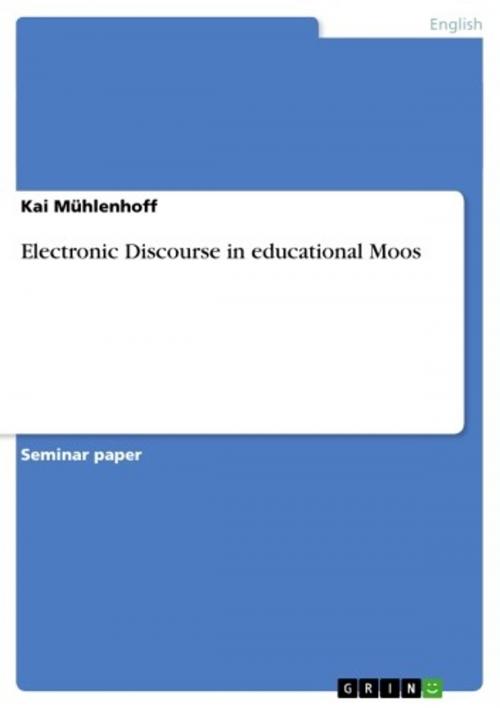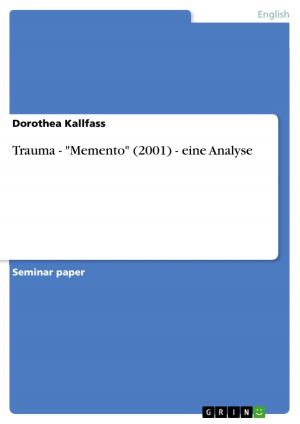| Author: | Kai Mühlenhoff | ISBN: | 9783638223409 |
| Publisher: | GRIN Publishing | Publication: | October 15, 2003 |
| Imprint: | GRIN Publishing | Language: | English |
| Author: | Kai Mühlenhoff |
| ISBN: | 9783638223409 |
| Publisher: | GRIN Publishing |
| Publication: | October 15, 2003 |
| Imprint: | GRIN Publishing |
| Language: | English |
Seminar paper from the year 2003 in the subject English Language and Literature Studies - Other, grade: 1,3 (A), University of Münster (English Seminar), course: Didactics Advanced Seminar, 22 entries in the bibliography, language: English, abstract: [...] In our introduction, we first want to draw on the field of educational MOOs. The upcoming of personal computers, it's speedy with more advancing progress up to this date and the easy accessibility at home or in educational institutions such as schools and universities. Language Classes in universities for example, have already led the 1980s to an ever increasing awareness that there is an almost unsustainable and enormously large potential in its use for classroom purposes and other activities. Although manifold, in the focus of our interest (for we are dealing with EFL learning in our seminar) we measured L2 acquisition and the learnability of a Foreign Language with the help of a computer program. We will thus narrow down several possible choices we could make relating to teaching/learning software and choose one of them. The program that we will thoroughly discuss in the next few chapters is one that already, from a technological standpoint, has a long history. We must look back to 1979 when the first virtual MUD (Multi-User Dungeon or Multi-User Domain), the predecessor of the MOO (Multi-User Domain, Object-Oriented) comes into play. MUDs do not crucially differ from MOOs, as becomes evident in their being virtually the same program based on a similar code, the MOO, however, evolved from the MUD as a more advanced version sporting some more additional and useful features and making it therefore better to use for classroom purposes.1 First of all, what is a/the MOO? The MOO is a publicly accessible database, available and accessible from anywhere on the world via network systems like, most popular, the Internet. Users must log on to a server in order to gain access. Some of this works via telnet or clients include MacMOOSE, Pueblo or encore Xpress. Curtis and Nichols say that MOOs are 'frequently referred to as text-based virtual realities' (own italics, K.M, D.B) (TBVRs)2, because they are based on unformatted text, rather than a colourful user graphic interface (UGI). The term object-oriented, hidden in MOO, means MOO players can add new spaces in the form of rooms or other objects to the classroom. 1 To provide the reader with a complete history on MUD/MOO environments would by far exceed the length of this paper. For a complete history, see Holmevik, Jan Rune; Haynes, Cynthia: MOOniversity:a student´s guide to online learning environments. 2000. p. 1 ff. 2 Curtis/Nichols 1993: n.p.
Seminar paper from the year 2003 in the subject English Language and Literature Studies - Other, grade: 1,3 (A), University of Münster (English Seminar), course: Didactics Advanced Seminar, 22 entries in the bibliography, language: English, abstract: [...] In our introduction, we first want to draw on the field of educational MOOs. The upcoming of personal computers, it's speedy with more advancing progress up to this date and the easy accessibility at home or in educational institutions such as schools and universities. Language Classes in universities for example, have already led the 1980s to an ever increasing awareness that there is an almost unsustainable and enormously large potential in its use for classroom purposes and other activities. Although manifold, in the focus of our interest (for we are dealing with EFL learning in our seminar) we measured L2 acquisition and the learnability of a Foreign Language with the help of a computer program. We will thus narrow down several possible choices we could make relating to teaching/learning software and choose one of them. The program that we will thoroughly discuss in the next few chapters is one that already, from a technological standpoint, has a long history. We must look back to 1979 when the first virtual MUD (Multi-User Dungeon or Multi-User Domain), the predecessor of the MOO (Multi-User Domain, Object-Oriented) comes into play. MUDs do not crucially differ from MOOs, as becomes evident in their being virtually the same program based on a similar code, the MOO, however, evolved from the MUD as a more advanced version sporting some more additional and useful features and making it therefore better to use for classroom purposes.1 First of all, what is a/the MOO? The MOO is a publicly accessible database, available and accessible from anywhere on the world via network systems like, most popular, the Internet. Users must log on to a server in order to gain access. Some of this works via telnet or clients include MacMOOSE, Pueblo or encore Xpress. Curtis and Nichols say that MOOs are 'frequently referred to as text-based virtual realities' (own italics, K.M, D.B) (TBVRs)2, because they are based on unformatted text, rather than a colourful user graphic interface (UGI). The term object-oriented, hidden in MOO, means MOO players can add new spaces in the form of rooms or other objects to the classroom. 1 To provide the reader with a complete history on MUD/MOO environments would by far exceed the length of this paper. For a complete history, see Holmevik, Jan Rune; Haynes, Cynthia: MOOniversity:a student´s guide to online learning environments. 2000. p. 1 ff. 2 Curtis/Nichols 1993: n.p.















